
Over 370 registrants from 30 countries attended our 1st ever web-based Scientific Meeting!
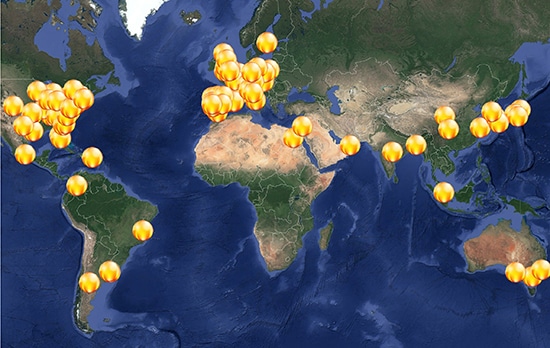
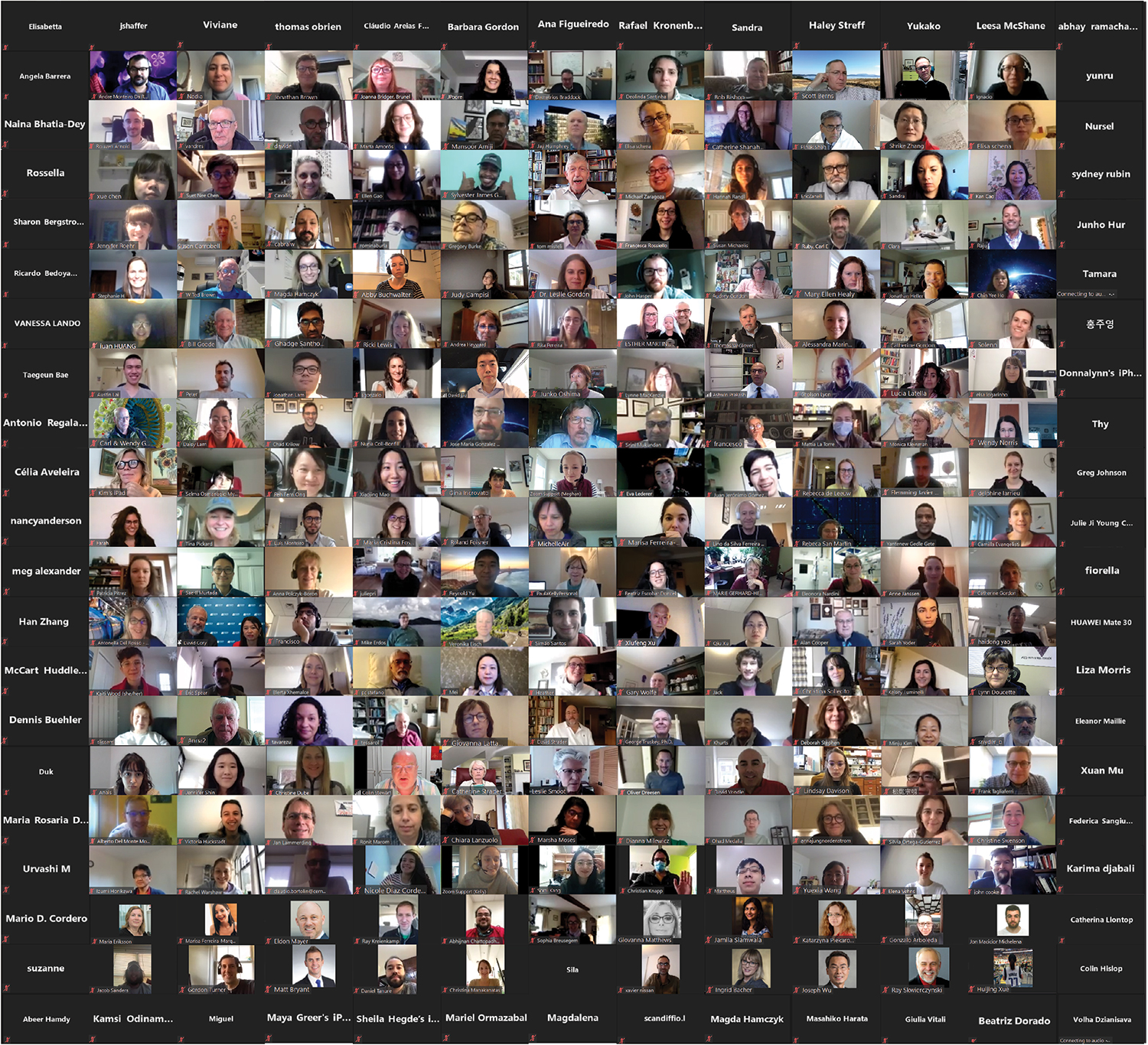
We hope you enjoy this clip from our 2020 International Workshop,
“Researching Possibilities, ExTENding Lives” webinar
All rights reserved. Please do not download, copy, distribute, or modify this presentation in any way.
Unanswered Chat Questions
To Dr. Francis Collins: Question: From Mansoor Amiji: Dr. Collins, have you looked at the biodistribution of the PPPMO upon systemic
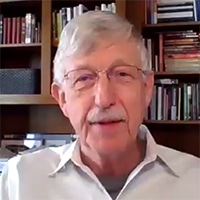 Answer: PK/PD studies indicated 100% bioavailability in heart, aorta and kidney. Kidney was the only tissue where there was a suggestion of accumulation, based on histologic examination and PK/PD data. Single dose administration of SRP-2001 demonstrated that PPMO was rapidly cleared from heart (within 2 hours), cleared from aorta within 4 hours, but sustained in kidney to the 48hr timepoint. Quantitative ddPCR demonstrated G608G cryptic splice inhibition activity in all tissues except skin tested thus far (aorta, heart, kidney, liver, quadriceps, bone), although activity varied depending on the tissue.
Answer: PK/PD studies indicated 100% bioavailability in heart, aorta and kidney. Kidney was the only tissue where there was a suggestion of accumulation, based on histologic examination and PK/PD data. Single dose administration of SRP-2001 demonstrated that PPMO was rapidly cleared from heart (within 2 hours), cleared from aorta within 4 hours, but sustained in kidney to the 48hr timepoint. Quantitative ddPCR demonstrated G608G cryptic splice inhibition activity in all tissues except skin tested thus far (aorta, heart, kidney, liver, quadriceps, bone), although activity varied depending on the tissue.
Francis, Mike, and Wayne
To Dr. Pinak Shah and Dr. Francesco Musumeci: Question: From RVB: Can magnesium/calcium intake determine the degree of calcification in children with HGPS?
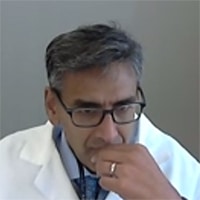 Answer:Regarding the question, to be honest, I don’t know the answer to this question. In a typical adult, however, we do not correlate degree of valvular calcification with Mg/Ca intake, the heavier calcification is likely due to other factors.
Answer:Regarding the question, to be honest, I don’t know the answer to this question. In a typical adult, however, we do not correlate degree of valvular calcification with Mg/Ca intake, the heavier calcification is likely due to other factors.
Dr. Pinak Shah
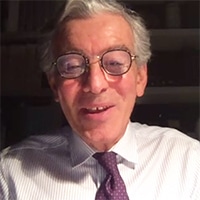 Answer: I agree with Dr. Shah opinion. Probably causes of valve calcification in HGPS are different from the one we see in elderly patients. I also have no knowledge on Ca and Mg metabolism.
Answer: I agree with Dr. Shah opinion. Probably causes of valve calcification in HGPS are different from the one we see in elderly patients. I also have no knowledge on Ca and Mg metabolism.
Dr. Francesco Musumeci
To Dr. Vicente Andres: Question: From Andre Monteiro Da Rocha - University of Michigan: Do the mice lacking Lamin A develop DCM?
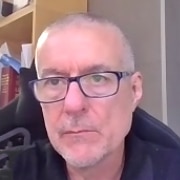 Answer: The lamin A/C null (Lmna-/-) mouse model develops DCM accompanied with loss of cardiac function. Moreover, these mice exhibit defects in cardiac conduction and extensive cardiac fibrosis, and premature death at 5-8 weeks of age (Auguste et al., 2018; Frock et al., 2012; Sullivan, 1999). However, mouse models lacking only Lamin A (Fong et al., 2006) or lamin C (Coffinier et al., 2010) do not show cardiac defects and have a normal lifespan.
Answer: The lamin A/C null (Lmna-/-) mouse model develops DCM accompanied with loss of cardiac function. Moreover, these mice exhibit defects in cardiac conduction and extensive cardiac fibrosis, and premature death at 5-8 weeks of age (Auguste et al., 2018; Frock et al., 2012; Sullivan, 1999). However, mouse models lacking only Lamin A (Fong et al., 2006) or lamin C (Coffinier et al., 2010) do not show cardiac defects and have a normal lifespan.
References:
Auguste, G., Gurha, P., Lombardi, R., Coarfa, C., Willerson, J. T., & Marian, A. J. (2018). Suppression of Activated FOXO Transcription Factors in the Heart Prolongs Survival in a Mouse Model of Laminopathies. https://doi.org/10.1161/CIRCRESAHA.117.312052
Coffinier, C., Jung, H. J., Li, Z., Nobumori, C., Yun, U. J., Farber, E. A., Davies, B. S., Weinstein, M. M., Yang, S. H., Lammerding, J., Farahani, J. N., Bentolila, L. A., Fong, L. G., & Young, S. G. (2010). Direct synthesis of lamin A, bypassing prelamin a processing, causes misshapen nuclei in fibroblasts but no detectable pathology in mice. Journal of Biological Chemistry, 285(27), 20818–20826. https://doi.org/10.1074/jbc.M110.128835
Fong, L. G., Bergo, M. O., Young, S. G., Fong, L. G., Ng, J. K., Lammerding, J., Vickers, T. A., Meta, M., Coté, N., Gavino, B., Qiao, X., Chang, S. Y., Young, S. R., Yang, S. H., Stewart, C. L., Lee, R. T., Bennett, C. F., Bergo, M. O., & Young, S. G. (2006). Prelamin A and lamin A appear to be dispensable in the nuclear lamina. The Journal of Clinical Investigation, 116(3), 743–752. https://doi.org/10.1172/JCI27125.with
Frock, R. L., Chen, S. C., Da, D., Frett, E., Lau, C., Brown, C., Pak, D. N., Wang, Y., Muchir, A., Worman, H. J., Santana, L. F., Ladiges, W. C., Rabinovitch, P. S., & Kennedy, B. K. (2012). Cardiomyocyte-specific expression of lamin A improves cardiac function in Lmna-/- mice. PLoS ONE, 7(8), 1–9. https://doi.org/10.1371/journal.pone.0042918
Sullivan, T. (1999). Loss of A-type lamin expression compromises nuclear envelope integrity leading to muscular dystrophy. The Journal of Cell Biology, 147(5), 913–920. https://doi.org/10.1083/jcb.147.5.913
To Dr. Giovanna Lattanzi: 2 Questions and Answers for Dr. Lattanzi listed below.
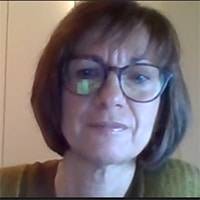 Question: From Tom Misteli: how long was the lonafarnib + tozilizumab treatment in animals?
Question: From Tom Misteli: how long was the lonafarnib + tozilizumab treatment in animals?
Answer: We performed a preliminary experiment in heterozygous animals starting at week 22 up to week 30. We wish to focus on this time frame to evaluate the effect on weight gain that was previously observed with tocilizumab.
Question: From Sgonzalo: Beautiful story Giovanna and Sammy!!! Did you see any side effects of tocilizumab treatment? Or any phenotypes that were not improved in progeria mice? To Dr. Giovanna Lattanzi: Question: From tom misteli: how long was the lonafarnib + tozilizumab treatment in animals?
Answer: Thank you Susana. No, we did not see any side effect of tocilizumab. Among the examined phenotypes (kyphosis, adipose tissue dystrophy, hair and skin defects, locomotor activity, aorta lesions and myocardium hyperthrophy) were delayed/improved.
Comment: From MARIE GERHARD-HERMAN : Also used in US for rheumatologist disease and vasculitis
Reply: Thank you Marie for this interesting info on the use for vasculitis.
Comment: From pc stefano: Tocilizumab is also approved in Japan for treating Castleman disease with no immunosoppressive effects
Reply: Thank you Stefano for these infos.
To Dr. Minju Kim and Somi Kang who presented on behalf of Dr. Bum-Joon Park: 8 Questions and Answers for Dr. Minju Kim and Somi Kanglisted below.
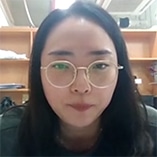

Question: From Delphine Larrieu: do you see any DNA damage decrease upon progerinin treatment in HGPS cells/HGPS mouse models?
Answer: We observed that DNA repair related genes(BRCA1, Rad51, etc) were altered after treatment with progerinin.
Question: From Delphine Larrieu: How does progerinin work in Werner
Syndrome that – as far as I know – does not express progerin? Does the molecule has any other targets?
Answer: WS cells can also produce a small amount of progerin like as normal aged
cells. We observed progerin expression in WS cells at mRNA levels.
We think that WRN protein can function to inhibit progerin. However, in the
case of WS patients, since there is no WRN protein, progerin expression is
thought to occur in the 20s and 30s, as much as it is seen in normally aged
people.
Question: From Bob Bishop: Is the progerinin binding site defined biochemically or
structurally? Is there a biochemical assay to find additional compounds
with this mechanism?
Answer: We performed biotin-avidin bead pull-down assay and observed the
specific interaction of perogerinin with progerin but not with lamin A, lamin
B, p53, or emerin.
We also perfomed Elisa assay to find additional compounds which could
be putative progerin/lamin A-binding inhibitors. Progerin recombinant protein was incubated sequentially with a chemical library and lamin A.
However, progerinin was the most effective chemical in the chemical
library.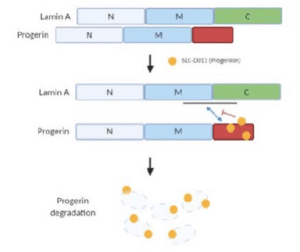
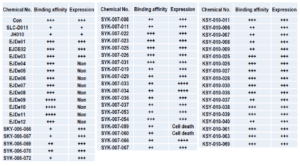
Question: From John Cooke: Great progress Dr. Kim. Does Progerinin reduce the
secretion of SASP cytokines?
Answer: We observed that progerinin could reduce the expression of IL6 and IL8 in
HGPS cells.
Question: From Susan Michaelis: is progerinin available to researchers?
Answer: Of course, it is available if you request.
Question: From Thomas W Glover: I may have missed it but what do you think is the
mechanism responsible for the beneficial effects in Werner syndrome?
Answer: WS patients-derived cells also produce a small amount of progerin, as
much as normal cells derived from aged people. Progerinin can be also
effective in WS cells by reducing progerin expression.
To Dr. Martin Bergö: Question: From Mario D. Cordero: Have you studied the effect about inflammation?
 Answer: Thanks for the question: No, not inflammation per se. Partially related to inflammation, we have studied macrophages in this project and found that knockout of Icmt in increases macrophage cholesterol efflux, both basal and ApoAI- and HDL-stimulated. As this effect is somtimes associated with increased reverse cholesterol transport in vivo, we would like to determine if Icmt inhibition would reduce atherosclerosis development.
Answer: Thanks for the question: No, not inflammation per se. Partially related to inflammation, we have studied macrophages in this project and found that knockout of Icmt in increases macrophage cholesterol efflux, both basal and ApoAI- and HDL-stimulated. As this effect is somtimes associated with increased reverse cholesterol transport in vivo, we would like to determine if Icmt inhibition would reduce atherosclerosis development.
To Dr. David Liu: Question: 3 Questions and Answers for Dr. Lui listed below.
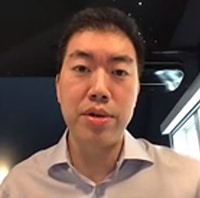
Question: From vandres: have you tried DNA correction in human HGPS fibroblasts of different ages (in vitro) and tested the normalization of their phenotype to see if it decreases as the cells age?
Answer: No, we haven’t tried correction in fibroblasts from patients of several different ages—only from two different patients, which yielded similar results.
Question: From Delphine Larrieu: Amazing effects! Would you expect a complete progerin KO in heterozygous mice?
Answer: In the single-copy mouse, I wouldn’t necessarily expect much different editing efficiencies than what we currently observe, since there should already an excess of editing agent for each progerin.
Question: From Andre Monteiro Da Rocha: Do you think that reprogramming of a low percentage of cells can repair stem cell function, but might lead to adult stem cell exhaustion?
Answer: We don’t have any data that can inform an answer to this question.
To Dr. Colin Stewart: 8 Questions and Answers for Dr. Stewart listed below.
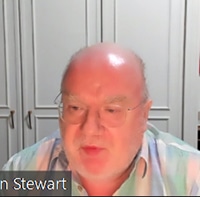 Question: From Mei: Looks like cardiomyocyte, beautiful staining!
Question: From Mei: Looks like cardiomyocyte, beautiful staining!
From Abby Buchwalter: Does dominant negative Sun1 expression disrupt all LINC complexes, including those mediated by Sun2?
Answer: Yes there is evidence for this in vitro in that all Nesprins in the NE can be displaced by DNSUN1
Question: From Suet Nee Chen: how and what is the mechanism that the AAV9-SunDn capable of having a long term effects? at what age did you injected the AAV9-Sun1DN to the LMNA mutant mice?
Answer: We injected the DNSUN1 AAV a day after inducing the Cre recombinase to delete laminA. We have data that the DNSUN1 delivered by AAV continues to be expressed I nthe cardiomyocytes a year after injection. We are doing dose /timing/reponse experiments now that we are back in the lab and can make our own AAV at sufficient quantiies
Question: From Martin Bergö, Viceordförande Kommittén för forskning: What do you think is the relative contribution of absent lamin A versus lamin C in your Lmna knockout experiments?
Answer: I’m not sure about this but Sun1 interacts with LaminA and the in the HGPS mice the the contribution must be all LaminA (from which progerin is derived)
Question: From jcampisi: What is the cause of death in SUN1 KO or hets?
Answer: Good question we still don’t know but currently suspect some skeletal muscle group We need t od oa decent histo-patho analysis of the dying mice
Question: From Tom Misteli: Colin: have you seen changes in cellular stress response pathways in the Lmna/Sun animals?
Answer: We have not yet measured any stress response genes/markers in these mice
Question: From Delphine Larrieu: Would you envisage targeting only the heart with the DNSUN1 in HGPS patients?
Answer: That is possible given the serotype and use of a cardiomyocyte specific promoter. Those experiments are currently in progress
Question:From Yuexia Wang: Why KO SUN1 has less benefit on homozygous G609G mice?
Answer: Presumably because the homozygouse mice are expressing more Progerin. We see a does response effect of heterozygotes v homozygotes in our genetic experiments
Question:From Roland Foisner: Hi Colin, nice talk. What is the negative effect of upregulated SUN1 in HGPS. Roland
Answer: Probably increased association of the MT network with the LINC complex. Increased Sun/Nesprin expression in cultures cells affects nuclear positioning and cell migration

A Sampling from the Chat Comments!
An honor to meet the Basso and Peraut family. Thank you for sharing your journey. You are truly and inspiration!
Thank you Sami and Alexandra’s family for being part of the workshop and sharing your inspirational journey with progeria!
Fantastic progress Eiger with approval on the horizon.
Can we extend this session to the end of the week and keep the discussion going? (THANK YOU, one and all!)
This workshop was incredible. I congratulate the PRF for having the commitment to do this great activity. Without a doubt, this workshop filled me with a lot of knowledge for my future. It was amazing. Together we will find the cure!
Always impressed by the exciting science at the PRF meetings. Many kudos to the organizers for preserving the community workshop experience even in this virtual format!
You all ROCK!!! Thanks for this great opportunity, thinking about many years ago, now it is like to live in the future! Happy to be part of it
I miss Dr. Collin’s guitar. Great job!
Thank you so much for organizing this, truly the highlight of my week!
Thanks to everyone and see you in person next year in Cambridge!!
Thank you all for joining us!

